You are currently browsing the final countdown category
At last, we’re up to the three-voters from my little ‘ol “Favorite 1980s Indies Comics” survey. Just for my own sanity/need for sleep, I may only do entries with one title at a time (like last time and today), but we’re in the home stretch so we’ll be done relatively soon!
And here we go:
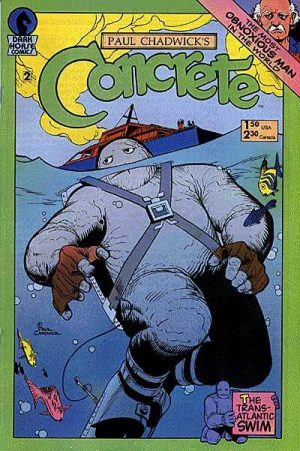 Concrete (Dark Horse 1987-1988)Paul Chadwick’s large rocky fella has been missing from the stands for quite a while (though with the occasional promise of a new series coming down the pike), but the character retains a beloved following among the comics cognoscenti even today.
Concrete (Dark Horse 1987-1988)Paul Chadwick’s large rocky fella has been missing from the stands for quite a while (though with the occasional promise of a new series coming down the pike), but the character retains a beloved following among the comics cognoscenti even today.
First appearing in Dark Horse Comics’ premier publication, Dark Horse Presents #1 in 1986, Concrete was primarily presented in short stories for the first year or so of his existence. The mostly down-to-Earth stories, told in a purposefully mundane and introspective style, presented the life of Concrete, a person in a huge rocky pody trying to adjust to living in a world too small and fragile for him. At the same time, Concrete uses the advantages conferred upon him by his body to go on exploratory adventures around the planet.
In this early period no explanation is given for Concrete’s existence, until early in his brief ongoing monthly series (the one listed in the header above). It’s aliens, what took political speechwriter Ron Lithgow and a pal who were on a hiking trip and for reasons yet unknown transplated their brains into these large artificial bodies. Aside from this origin (and an expanded retelling in a later mini-series), we don’t get any more aliens or monsters or whatever in the strip, leaving Concrete as the one fantastical element.
[NOTE: in the original telling of the origin, Concrete escapes the alien’s craft as it departs, while his hiking buddy remains behind. Chadwick had said in the past that his idea of the last Concrete story beginning with Concrete’s pal showing back up on his doorstep. In the expanded original, it appears that during the escape Concrete’s pal is killed, so either this was a fake-out or Chadwick’s changed his name on the ending.]
That monthly series ended in ’88, and was followed by several mini-series and one-shots (in color and in black and white). The most recent mini (The Human Dilemma ended in 2006 (on one heck of a cliffhanger), and some short stories that appeared in the revived Dark Horse Presents anthology were reprinted in a one-shot in 2012.
The Concrete stories have been reprinted a number of times in a number of formats, but the most convenient method of reading everything (or at least most everything, but I’m pretty sure these are comprehensive) would be this set of 7 trade paperbacks. This has everything except the 2012 one-shot. The books don’t appear to be currently available from Diamond but they should be relatively easy and inexpensive to find.
A movie was in the planning stages but alas was never to be. I think…Bill Murray was one of the names floated to voice the character? I still believe the comic would lend itself well to some form of adaptation, be it live action or animated. I would fear, though, it would stray too far from its low key comic origins and just go straight to “Concrete Vs. Aliens.”
This is a great series, well worth checking out in those collections or even just sampled out of back issue bins. And I hope we see new stories with Concrete again someday.
Today I am doing the last of the two-voter getters from my Fave ’80s Indies (plus Marvel/Epic Because Why Not) survey. It’s a long’un, so strap in:
Yummy Fur (Vortex/Drawn & Quarterly 1986-1994)
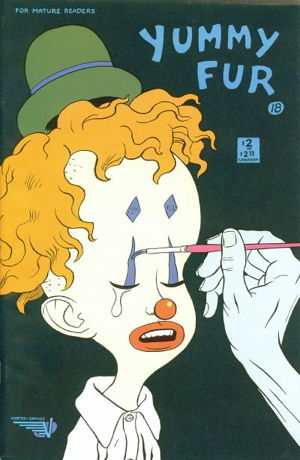 Yummy Fur started as a mini-comic self-published by cartoonist Chester Brown, running seven issues from 1983 to 1985. It would be picked up by Vortex Comics, reprinting the contents of those minis in the first three standard-sized comic issues and continuing with new material afterwards.
Yummy Fur started as a mini-comic self-published by cartoonist Chester Brown, running seven issues from 1983 to 1985. It would be picked up by Vortex Comics, reprinting the contents of those minis in the first three standard-sized comic issues and continuing with new material afterwards.
While many of the very earliest strips were short stand-alone gags, the main thrust of the book was the adventures of Ed the Happy Clown, to whom horrible things would happen and continue to happen through the features’ tenure in the book. However, some of those short seemingly unrelated strips would eventually feed into the main Ed narrative, most notably “The Man Who Couldn’t Stop” (about a man sitting on a toilet who, well, it says right on the tin, really).
The Ed stories tended to be surrealistic, morbidly humorous, occasionally shockingly violent, grotesque, and often a little sad. There’s a lady vampire in there too, who becomes one of Ed’s few friends in his travails. The childlike Ed just suffers through nightmarish scenario after nightmarish scenario, the peak of which is, well, the minature head of an other-dimensional Ronald Reagan replacing part of his penis. Hence:
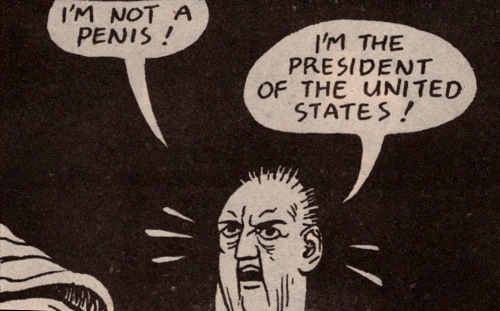
And on top of all this, most issues featured as back-up stories just straight adaptations of stories from The Bible, which also seemed to occasionally feed, at least thematically, into the lead feature. Was it a strange mix? Oh, certainly. But it was all done so…plainly and matter-of-factly that both the humor and the horror were unfettered by any sort of distance between the narrative and reader. It was right there, in your face but not overblown, presented in an almost mundane way.
After ending the Ed story in #18, Brown moved on to more down-to-earth autobiographical stories (but not without the occasional flight of fancy, such as in “The Little Man”) which ran through the rest of the series. The Bible back-ups continued as well. This was at the height of the autobiographical indie comic, and Brown was one of the most prominent in the genre.
There have been numerous reprints from this series, and it gets a little confusing particularly with the “Ed the Happy Clown” material. (One should also note that Brown did self-publish a collection of the first six minis in ’85.) I’m delving into the Wikipedia article to keep it all straight. However, I do own the initial trade paperback reprint from 1989, which contains the Ed-related stories from the first 12 issues and a foreward by Harvey Pekar.
The second Ed collection from 1992 also ends the reprints at issue #12 (with some material from a later issue), and includes a new ending.
In 2005-6, there was a nine-issue Ed the Happy Clown comic series from Drawn & Quarterly, re-presenting the Ed story as it appears in its definitive, “truncated” version from 1992, along with notes from Brown. This was collected into the 2012 Ed the Happy Clown hardcover, which is still available as I type this.
And the later autobiographical material has been collected into three volumes: The Little Man (various short strips), The PLayboy (about Brown’s fascination with said magazine), and I Never Liked You (the life and loves of Teenage Chester). Not reprinted is a big chunk of the latter “Ed” stories (from #13 – #18, though portions of #17 make it into the “definitive” edition), and I believe a few things from the “mini-comics” era also remain unreprinted. The Bible stories are also uncollected, far as I can tell, which honestly surprises me a little.
Long, long-time readers of this site know that I had some trouble tracking down a couple issues of Yummy Fur for the longest time. #6 and #9 eluded me for years, though I did eventually track them both down. Issue #9 was the last, getting a copy from, of all places, Scott McCloud’s collection back in 2013.
Now I knew one of the reasons some of those issues of Yummy Fur were so hard to find was that Diamond Comic Distributors decided to not carry the title for a while, presumably to make room for higher quality, better selling material. Eventually, after all the accolades Yummy Fur received, Diamond was shamed into carrying it again. According to the Wiki article, because of being dropped by Diamond, ordered bottomed out on #9, with a reported print run of under 1,700 copies. No wonder it was such a pain in the ass to find this stupid issue.
Anyway, Yummy Fur is pretty great. It’s a shame that so much of the Ed story was removed from the “definitive” edition, but those later issues should be sorta relatively easy to find. So, get the official story in the hardcover, and get the “deleted scenes” in issues #13-#18. The autobio stuff is entertaining, too…Chester doesn’t really pull any punches in depicting his life, so brace yourself for some cringey discomfort. Hope you like masturbation!
But if you want the Bible stories, you’re gonna have to buy the original issues. In fact, ideally, you should get a full run of the series for the unadulterated experience. I mean, good luck finding #9. No, you can’t have mine.
• • •
Okay, that’s it for the two-voters…on to see what series got
three votes in my little ’80s indie overview thingie! Thanks for reading, pals!
At long last, here is the next installment of our little ’80s indie overview here, as voted upon by YOU, the people what still read the blogs and also a few people I cajoled into voting on Twitter.
And speaking of the Twitter, a couple of you have wondered what happened to my Twitter feed that used to be in the sidebar on this site. Well, I mean, it’s still there, it’s just not working anymore aside from a link that won’t do you any good unless you’re on Twitter, too. For reasons too stupid to go into, Twitter’s new owner Elon Musk decided to no longer 1) feed out tweets through embedded widgets like the thingie I had in the sidebar, and 2) prevent anyone not logged into Twitter from being able to see anyone’s tweets.
So for those of you following my feed there, I’m sorry, it wasn’t my decision to cut you off. With luck Bluesky will open up to the public sometime soon and you can find me there (under mikester.bsky.social), and I’m also on Mastodon, and if you absolutely have to, I’m “mikesterlingjr” on Threads. I really don’t like Threads. Don’t forget you can usually find what I’m up to at mikesterling.com.
Enough of that nonsense, let’s talk some comical books:
Usagi Yojimbo (Fantagraphics 1987-1993)
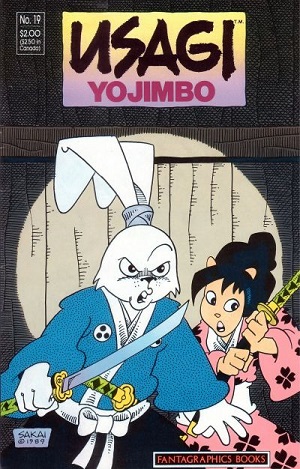 Hoo boy, where do I even start. Stan Sakai’s samurai rabbit has been going strong since debuting in Albedo Anthropomorphics #2 in 1984. After some appearances in that anthology, Usagi moved over to Fantagraphics, first in the anthology Critters, then a one-shot special, and then a 38-issue run of his own series (the one noted in the header above). From there the character moved to Mirage (the original publisher of Teenage Mutant Ninja Turtles) for a short run, then it was off to Dark Horse Comics for its longest numbered run from ’96 to 2018. Since then new Usagi has been coming from IDW, in both an ongoing series and various minis.
Hoo boy, where do I even start. Stan Sakai’s samurai rabbit has been going strong since debuting in Albedo Anthropomorphics #2 in 1984. After some appearances in that anthology, Usagi moved over to Fantagraphics, first in the anthology Critters, then a one-shot special, and then a 38-issue run of his own series (the one noted in the header above). From there the character moved to Mirage (the original publisher of Teenage Mutant Ninja Turtles) for a short run, then it was off to Dark Horse Comics for its longest numbered run from ’96 to 2018. Since then new Usagi has been coming from IDW, in both an ongoing series and various minis.
That’s just a barebones overview of its publishing history, not mentioning stuff like the Space Usagi mini-series (leaving the usual setting of Japan from centuries ago and presenting the adventures of Usagi’s descendant in a sci-fi future), or the various crossovers with the aforementioned Mutant Turtles (one series going on even as I type). There are literally thousands of pages of story produced over the last few decades, and nearly all of it has been reprinted; I direct you to this part of the Wikipedia entry to find what comics show up where.
“Yes yes, but is it any good, Mike?” The answer is “yes, it is excellent.” I missed out on buying it from the start (though I have on very rare occasions held that Albedo #2 in my hands), but I tend to drop in on the character from time to time, at one point several years ago sitting down and reading, like, sixty in-sequence issues that showed up in a collection. Sakai’s storytelling, from his scripts to his art to even his lettering (the last of which very familiar to Groo the Wanderer fans), is flawless. Sakai populates his book with a cast of anthropomorphized animals (including the lead: “Usagi” is Japanese for “rabbit”), and tells a straight, serious (but not without its moment of humor) tale of his lead’s relationships, adventures, and travails.
The character has appeared in various animated adaptions, perhaps most famously in the original 1980s Teenage Mutant Ninja Turtles cartoon, and then later in the 2012 TMNT series. Most recently a CGI cartoon has been appearing on Netflix, which, like Space Usagi, is set in the future. Haven’t seen it, but I feel like not putting it in the Japan of the past was a lost opportunity. I don’t know, like I said, I haven’t seen it, maybe someone can tell me if it’s any good.
But what is good is Usagi Yojimbo comics. Well worth your time. I know there’s a lot of material out there, but Sakai’s master storytelling will draw you right in and tell you everything you need to know to enjoy what you’re reading. Easily one of the best comic books ever produced.
Xenozoic Tales (Kitchen Sink 1987-1996)
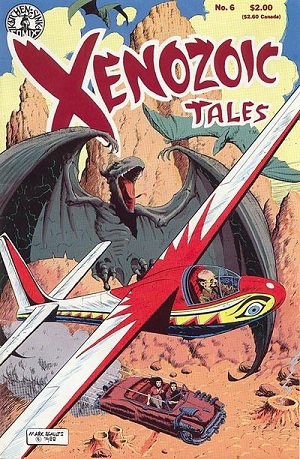 But Xenozoic Tales ain’t no slouch either. Mark Shultz’s very EC Comics-inspired series is set in a post-apocalyptic future where prehistoric beasts once again roam the Earth. The concept was introduced in a short story in the Kitchen Sink legacy underground title Death Rattle in ’86, before getting its own series in ’87. 14 issues were produced in a ten year span afterwards, taking a while due to the meticulous art, but probably also due…
But Xenozoic Tales ain’t no slouch either. Mark Shultz’s very EC Comics-inspired series is set in a post-apocalyptic future where prehistoric beasts once again roam the Earth. The concept was introduced in a short story in the Kitchen Sink legacy underground title Death Rattle in ’86, before getting its own series in ’87. 14 issues were produced in a ten year span afterwards, taking a while due to the meticulous art, but probably also due…
…to the advent of Cadillacs and Dinosaurs, an animated adaptation of the comic that debuted in 1993 and ran for one season. I imagine the development of the show took up some of Mr. Schultz’s time.
The Cadillacs and Dinosaurs name had appeared previously, when Marvel acquired reprint rights and reprinted the first six issues in color. That title was used again on a handful of series published by Topps Comics in the mid-1990s, which were new stories written and drawn by hands other than Schultz.
There have been multiple reprints over the years, but none appear currently available from Diamond. Dark Horse had a two-volume series that reprints all of Schultz’s work from book. There has also been a hardcover edition from Flesk that puts everything under one cover. If you want to go for the original comics, they shouldn’t be expensive, but may be a little harder to find now. But it’s well worth the search…these are some beautiful-looking funnybooks.
• • •
Okay, I should wrap up the two-voters next time. Thanks for reading, folks and I’ll catch you on the flip-flop.
So here we are, finally up to the two-vote getters in my little survey from a while back re: Your Favorite ’80s Indies That Aren’t Actually Comics Like Elfquest and Cerebus That Started in the ’70s.
And today’s entry features a couple of heavy-hitters from the period, so this post may get a little more attention than normal. As such, let me point out to anyone new that the dates presented represent the length of the initial run of the subject’s first primary series, so it may skip earlier appearances as back-ups or anthology entries an’ such. (I fudge this a little in the Nexus entry.) Admittedly, I should have just noted “year of first appearance” or something, but no,I had to be more difficult about it. Anyway, I do at least try to mention those earlier appearances.
Got it? Good! Confused? Probably also good! So here we go….
Elementals (Comico 1984-1988)
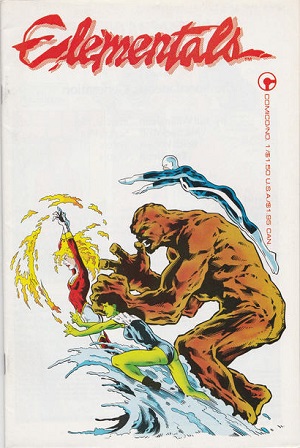 I recently had…not a full set of all the Elementals (at least, the “good” ones, more on that in a moment), but pretty close, and a friend who had an interest in reading those but missed ’em the first time around expressed interest. After taking them home and reading them, he reported back “…um, yeah, not for me.”
I recently had…not a full set of all the Elementals (at least, the “good” ones, more on that in a moment), but pretty close, and a friend who had an interest in reading those but missed ’em the first time around expressed interest. After taking them home and reading them, he reported back “…um, yeah, not for me.”
Here’s the thing, I’m still interested in reading these all in sequence someday. I’ve read scattered issues here and there, I’ve glanced through them at the shop, I generally like Bill Willingham’s work from this period (fresh from the TSR ads). Thus, I have at least a passing familiarity with the books.
First appearing in Texas Comics’ Justice Machine Annual #1 in 1983, they got their first ongoing series from Comico the following year when the previous company went other. The comic, about four people who had died but were revived with power over the element that caused their demise (the woman who drowned getting water-based powers, for example) ran 29 issues. Willingham wrote and drew most issues through 23, with occasional guest stints from other artists. Jill Thompson is probably the most notable, and she draws the remainder of the series through to 29 after Willingham’s departure. There was also an Elementals Special published in ’86, drawn by Willingham and written by Jack Herman.
Willingham returns to script the second series, and provide covers, which starts in 1989. Mike Leeke is the main artist for this run, aside from the occasional assist from guest-artists like Chuck Austen and Adam Hughes. With #23 Willingham is gone again, and other hands bring this series to its conclusion in 1993 with #26. (Willingham did write and draw a second special in 1989.)
There was also the Elementals Sex Special, an adults-only series that ran 4 issues from 1991-3, with Willingham involved only in #1. Another two-issue run under this title was issued in 1997. If that’s not enough, there was the Sexy Lingerie Special, a 1996 Swimsuit Special, and well, you can see what the new owners of this property, having acquired it from Willingham, think of the whole thing. There were a couple of attempts at actual narrative for these characters in the mid-late-ish ’90s but that was pretty much that. And Willingham’s out so he’s not going to revive the property (but he was credited on something called Ghost of a Chance as writer, Tony Akins on art, in 1995 that I thought was reprints but is maybe new? If someone out there knows for sure, please drop me a line (or a comment).
Oh, and I should note the early crossover mini Justice Machine featuring the Elementals from 1986, script by Willingham.
So, that’s a lot of stuff, and aside from maybe a trade paperback or two, there’s never been a comprehensive reprinting of this material, nor is there likely to be one. Fortunately, the once relatively sky-high prices on that Justice Machine Annual and the first Comico issue have come way, way down, and everything else should be cheap cheap cheap. You can probably get by without anything published after the end of the second series (except maybe that Ghost of a Chance book, depending if it’s new stuff by Willingham or not). I like the concept of the series, and it’s a shame it got out of the control of its creator.
Nexus (Capital/First 1981-1991)
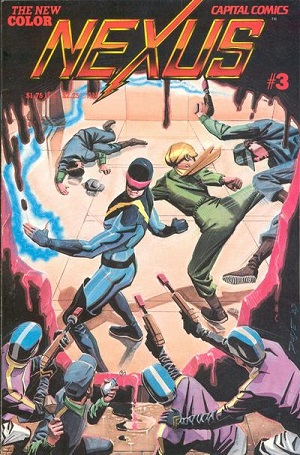 I wrote about Nexus a few months back, on the occasion of a new (and, um, pretty overpriced for what you got) graphic novel. Despite that, the series has featured some remarkable and memorable work over the decades, primarily the the comic’s creators Mike Baron and Steve Rude.
I wrote about Nexus a few months back, on the occasion of a new (and, um, pretty overpriced for what you got) graphic novel. Despite that, the series has featured some remarkable and memorable work over the decades, primarily the the comic’s creators Mike Baron and Steve Rude.
Beginning with a three-issue run of a black and white magazine in 1981-2, Nexus continued as a color comic (with a new #1) in ’83. This was under the Capital Comics banner, but the series ended with #6 in 1984, moving to First Comics in ’85 and running ’til issue 80 in 1991. Mike Baron wrote pretty much everything, Rude drew primarily in the first half of the series, with an array of usually top-flight artists (like Paul Smith!) doing the rest of the work. Given the premise of the series (Nexus is compelled by dreams to find and execute mass-murderers) it seems like it would just wallow in darkness, but it remains energetic and fun and inventive pretty much through its entire existence.
Following First’s demise, Dark Horse picked up the property and issued a whole slew of mini-series, several by Baron and Rude, some by other creators (like 1992’s Nexus the Liberator). The ’90s also brought us intercompany crossovers teaming Nexus with Madman (and The Jam) and Magnus Robot Fighter.
There were also plenty of tie-in minis and one-shots featuring Nexus’s pals and gals, both from First and Dark Horse. Most notable were Next Nexus from First, the handful of Hammer of God minis from both companies (starring best pal Judah), Mezz: Galactic Tour 2494, and, of course, the Clonezone Special (issued by Dark Horse whilst Nexus was still at First, curiously enough — one can only presume First was too chicken to publish it).
Post-Dark Horse, there was a short run in the mid-2000s from “Rude Dude Productions,” reteaming Baron and Rude on the character. Also released was a collection of “Newspaper Strips” (which I think were a Kickstarter or subscription thing?). The 2010s version of Dark Horse Presents had some serialized stories. And then there was that recent graphic novel I linked to above.
If you’re trying to catch up on Nexus now, well, good luck friend as I think a lot of the books are out of print, but Wikipedia has a list of what’s been reprinted and how. Looks like the Omnibii are the way to go, all you have to do is find the darned things.
The first three magazine-sized issues were reprinted in a nice trade by First (sans the flexidisc from the third issue) at their original size, so I think that likely looks better than being shrunk down to comic-sized pages in the Archives/Omnibus books. But that’s just me, the guy with crummy eyes who wants larger pages to look at. There was also a standalone trade of Next Nexus, and there was a reprint series called Nexus Legends that presented the early color issues.
This was a good series, with a fleshed-out universe and interesting and unusual characters (and the occasional guest-appearance of that other Mike Baron character the Badger), and I sorta miss having a new issue of this to look forward to every month. Rude apparently has a new Nexus graphic novel on the way, and supposedly he’s also split with Baron, so…we’ll have two competing Nexus continuities, I guess? Well, I guess we’ll see what actually comes out.
If I were to recommend any Nexus, I’d say “start with the early stuff” and so long as Rude is drawing, you’re in for a good time. The first dozen or so color issues are, like, Peak Nexus, but there’s lots of good stuff elsewhere in the run. Ah heck, just read ’em all. Get those ominuses as you can!
• • •
Only
two this time? Yes, sorry, the mind is able, but the flesh is…sleepy. Well, so’s my mind, while I’m thinking about it. Anyway, got to give it a rest tonight, and I’ll see you guys back here soon.
So here we go, the last of the single-vote getters from this informal survey way back when. That means the two-voters are next! Are you excited? Sure you are!
Tales from the Heart (Entropy Enterprises/Slave Labor Graphics (1987-1994)
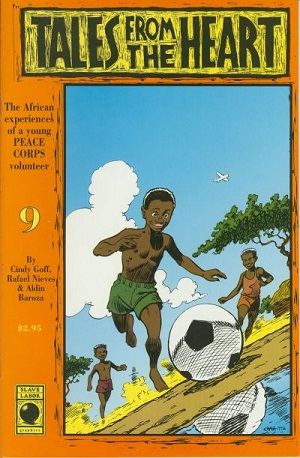 Hoo boy, okay, here’s the one when I first saw it mentioned I realized “I’ve got a lot of vamping up ahead given the number of comics in this list I haven’t read or even have stories about.” And I apologize…I do recall this comic, about a volunteer in the Peace Corps and her work in Africa, coming out and having a small but loyal following at the shop. Written by Cindy Goff and Rafael Nieves, and illustrated by Seitu Hayden, the series spanned three publishers: the eleven black and white issues from the companies noted above, and two one-shot color specials published under Marvel’s Epic imprint in the early 1990s.
Hoo boy, okay, here’s the one when I first saw it mentioned I realized “I’ve got a lot of vamping up ahead given the number of comics in this list I haven’t read or even have stories about.” And I apologize…I do recall this comic, about a volunteer in the Peace Corps and her work in Africa, coming out and having a small but loyal following at the shop. Written by Cindy Goff and Rafael Nieves, and illustrated by Seitu Hayden, the series spanned three publishers: the eleven black and white issues from the companies noted above, and two one-shot color specials published under Marvel’s Epic imprint in the early 1990s.
That the series details the difficulties of trying to provide help is in contrast to the 1980s “raising money for Africa” trend that spread through pop culture, primarily though benefit concerts/songs and comic books. Which is of course a good thing, raising money for, and awareness of, those in need. But staying at home and donating cash is a more…removed experience from actually going there and doing the work. And there are criticisms all around, against what good the Peace Corp actually is doing, but look, I am but a humble comics blog simply Googling about, I don’t know the whole story. All I’m trying to say is that here’s somebody trying to relate what it’s like to be doing this sort of work and I think that’s an interesting standout for the period, especially in comics.
Teenage Mutant Ninja Turtles (Mirage Studios 1984-1993)
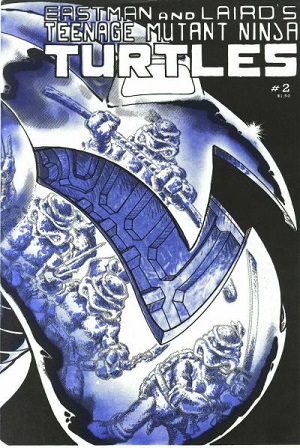 Where do I even start. Well, first, only one vote? Very surprising, even given the rather limited reach of my “poll.” Anyway, pictured there is issue #2 of the original series, the first to make it out to my local shop at the time (to be followed by a reprint of #1 a few weeks later). The first four issues were magazine-sized (apparently due to a misunderstanding between creators Kevin Eastman and Peter Laird and their printer), before finally going to a more standard comic size.
Where do I even start. Well, first, only one vote? Very surprising, even given the rather limited reach of my “poll.” Anyway, pictured there is issue #2 of the original series, the first to make it out to my local shop at the time (to be followed by a reprint of #1 a few weeks later). The first four issues were magazine-sized (apparently due to a misunderstanding between creators Kevin Eastman and Peter Laird and their printer), before finally going to a more standard comic size.
I’m sure you don’t need me to tell you what this comic’s about, and there is a boatload of lore, both in-universe and behind the scenes, that I’m not even going to scratch the surface of here. But this is the series that launched a thousand comic book spin-offs, cartoons, movies, video games, toys, live music concerts, whathaveyou, making lots of people very rich (including the creators, for once), and inspiring piles of rip-off comics that flooded the market in the hopes of Getting Rich Quick. Oh, the schemes I could share.
Anyway, the Turtles are immortal, and even though their first series ended in ’94, many relaunches followed, and I believe the current ongoing series from IDW is at around 150 issues. Reprints abound in multiple formats, a new “kid-friendly” (i.e. closer in style to the ’80s cartoon) launched recently, and Turtles stories will continue coming out long after all of us are dead. Pretty good for a comic parodying very specific comic characters, artists, and trends of the time.
Timespirits (Marvel/Epic 1984-1986)
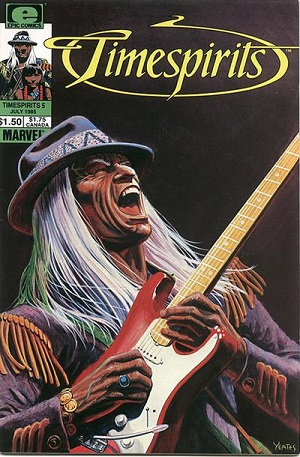 I didn’t read Timespirits, but I should have, given I’m a fan of artist Tom Yeates, who, with Steve Perry, produced all eight issues of this series.
I didn’t read Timespirits, but I should have, given I’m a fan of artist Tom Yeates, who, with Steve Perry, produced all eight issues of this series.
I’m going to cheat a little and let this website do the talking for me, as this is a good overview not just of the series itself, but of the the problems that arose when Perry and Yeates began to disagree with the direction of the book. Lots of citations from Amazing Heroes and The Comics Journal, which saves me from digging through my own copies.
However, I do still want to search my Journals when I have a little more time, as I do seem to recall a article about Yeates secretly investigating some political gathering or ‘nother as research for a story. Assuming this event didn’t form solely in my brain from a strong bump on the head, this seemed like a pretty wild thing to do for, well, a comic book. But hey, you got a story to tell, a message to get out, you do what you have to do. Allegedly. Look, it may not even have been Timespirits he was doing that for, but that’s how it stuck with me. I’ll check into it, if only to ensure that I’m not crazy.
Also, in searching around I’ve seen a handful of accusations that James Cameron’s Avatar movie “borrowed” from this series. Trying to find an article that goes into detail, though it seems to focus mostly around a blue “native” character? Anyway, looks like the “hot” comic sites have picked up on it, so maybe good luck trying to complete a run of this.
EDIT: I’m not crazy! Well, at least not about this. I found the article about Yeates’ investigation. I’ll post about it on Wednesday.
Wordsmith (Renegade Press (1985-1988)
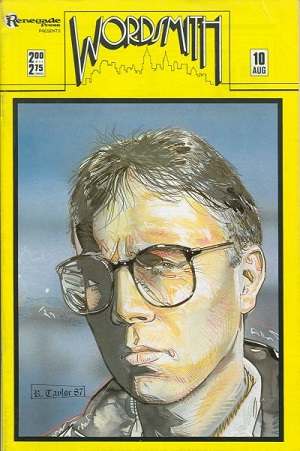 I could’ve sworn this series ran longer than it did, but on the other hand, the three or four year duration of the series was a lot longer than its twelve-issue run would suggest.
I could’ve sworn this series ran longer than it did, but on the other hand, the three or four year duration of the series was a lot longer than its twelve-issue run would suggest.
Written by Dave Darrigo, and illustrated by R.G. Taylor, the story concerned itself with Clay Washburn, a pulp writer active in the first half of the 20th century, contrasting his real world struggles with the heroes he’s scripting (whose adventures also occasionally pop up in the comic). It’s a neat concept for a series, and a shame it didn’t get more issues as I thought it did in my head. (See also Timespirits above for more of my possible delusions.)
There was also a one-shot spin-off in 1990, self-published by Darrigo, called Heroes from Wordsmith, focusing on the adventures of a couple of pulp characters from the main series. It’s hard to find info on this (even the Comics Database entry has nuthin’) but from what I gathered, this reprints material from the main series under a new Taylor cover, maybe? If anyone knows for certain, please inform me.
Also in 1990 Caliber Press would release two trade paperbacks, reprinting the whole series. Caliber would reprint the series again, a half-dozen years later, in a series of comics. Some of the issues of that series would be “flipbooks,” featuring other Caliber titles.
It feels like nearly anyone else would have taken this concept and given Washburn the ability to bring his pulp heroes “to life” and have them escape the printed page into his real world. Picturing this as a full-color superhero book from, I don’t know, Image, and running a long time and getting TV/movie deals and such. But good on this series for taking the more subtle and human route.
• • •
And that’s that for the one-voters! Thanks to everyone for reading and please come back when I start tackling those comics at least
two people agreed on!
What’s this? Three more in the “one vote” pile from this post? Let’s see what we’ve got this time:
Starstruck (Marvel/Epic 1985-1986)
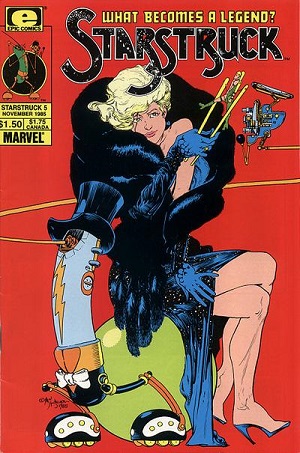 A reminder to folks new to these lists, that I was counting creator-owned books released under Marvel’s “Epic” imprint as part of the “indies” movement since they were mostly distinct from Marvel’s standard output. I mean, despite the fact Marvel’s editorial hand sometimes came down on them.
A reminder to folks new to these lists, that I was counting creator-owned books released under Marvel’s “Epic” imprint as part of the “indies” movement since they were mostly distinct from Marvel’s standard output. I mean, despite the fact Marvel’s editorial hand sometimes came down on them.
As to Starstruck itself, it began life at a stage play written by Elaine Lee, with costume and set design by William Kaluta and Charles Vess. It was a sci-fi comedy/adventure with a largely-female cast, set during a power struggle in a divided galaxy. Translating the project to comics, Lee and Kaluta serialized a prequel story in Heavy Metal, which were retooled into a graphic novel from Marvel. After that Lee and Kaluta produced a six issue comic book series through Epic.
After this it gets a little confusing, at least to me, the Guy Who Never Read This But Should Have. It appears the graphic novel was reprinted in altered/expanded form in a Dark Horse comic book mini-series in 1990-1. According to the Wikipedia entry, it also includes part of the first comic book issue from Epic.
In 2009-10 it appears the material was remastered and reprinted again, in a 13-issue series from IDW. This series was reprinted in its entirety in both hardcover and softcover, and this is like the Definite Edition of this story, if you ever decide to seek it out.
I remember the IDW reprints selling quite well for us at the previous place of employment. According to the Wiki more story is planned, so hopefully that’s something that will actually happen.
Steelgrip Starkey (Marvel/Epic 1986-1987)
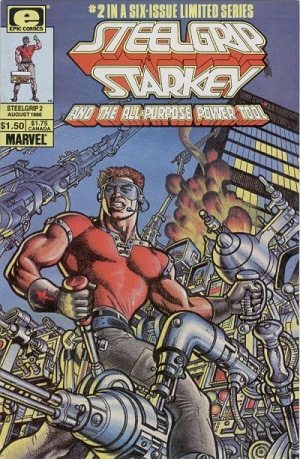 Another one of those darned Epic titles, this one with the subtitle on the cover “…And The All-Purpose Power Tool.” Which I don’t know was officially part of the title or not, since I don’t have a copy here to check the indicia.
Another one of those darned Epic titles, this one with the subtitle on the cover “…And The All-Purpose Power Tool.” Which I don’t know was officially part of the title or not, since I don’t have a copy here to check the indicia.
But this was a comic I had at least some mild interest in, as the main writer/artist of the book was Alan Weiss (inks by James Sherman), whose art in other comics I’ve read stuck out to be as being, well, different from your standard superhero fare. A little more detailed, more expressive, less “generic muscled body in spandex,” that sort of thing. For whatever reason, I never got around to picking it up, and look, I’m sorry this ’80s overview is turning into a parade of “Mike’s Missed Opportunities,” but what can I tell you, I can’t read everything.
Anyway, Val Mayerik pops in to share penciling duties for a couple of issues, and interestingly, in the section on the title in the Amazing Heroes 1985 Preview Special, Mike Kaluta (remember him?) was also namedropped as an artist on the series, though far as I can tell via the Comics Database, he doesn’t appear. (Also, Elaine Lee (remember her?) does some coloring here.)
Also “borrowing” from this preview entry is a description of the book, in that it’s a “modern American folk tale” in which Starkey, and his amazing tool only he can operate, find themselves in a series of adventures. Which, you know, okay, I’ll read that. I mean, I should have read it back in the ’80s when it was coming out, but look, I was still in high school, I wasn’t rolling in cash at the time. Though I suppose once I started working for a comic shop I could have snagged those, but I was trying to fill back numbers of Cerebus so that took priority. …Amazing all these things I could have had if only I’d taken more advantage of that store’s deep stock. Ah well.
Far as I can tell, the series has never been reprinted, making it another of those lost series awaiting rediscovery in a back issue bin or dollar box somewhere.
Strange Days (Eclipse 1984-1985)
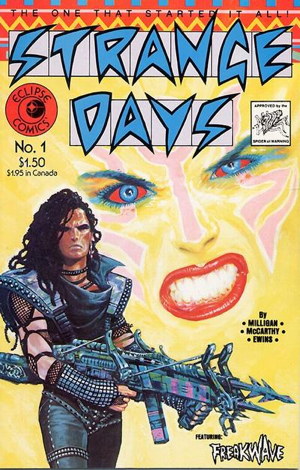 I’ll tell you what, though, when I saw that cover of Strange Days as a 15-year-old kid wandering around ye olde comic shoppe, that was a book I had to have. That weird face in the background, those obnoxious colors…it was a comic that dared you to buy it, and friends, I took that dare.
I’ll tell you what, though, when I saw that cover of Strange Days as a 15-year-old kid wandering around ye olde comic shoppe, that was a book I had to have. That weird face in the background, those obnoxious colors…it was a comic that dared you to buy it, and friends, I took that dare.
And the stories inside…”Paradax” by Peter Milligan and Brendan McCarthy, looked almost nominally like it should have been a superhero story, but it was just so peculiar, with splashy colorful art that made it look so unlike its flat-colored mainstream cousins. Maybe I wasn’t 100% sure what was going on, but oh goodness that art caught my eye. More so with “Freakwave” by the same fellas, where I feel like maybe I still need to give it another read and make sure I have it down.
And of course there was Johnny Nemo, the stylish sci-fi private detective by Milligan and Brett Ewins, plus other short features primarily with some combination of Milligan, McCarthy, and Ewins.
Much (all?) of the Millgan/McCarthy material gets reprinted in a 2013 hardcover Best of Milligan and McCarthy from Dark Horse. There is a two-issue Paradax series from Vortex that appears to be new material. There is a three issue series, also from Eclipse, of Johnny Nemo Magazine with new stories by Millgain and Erwin, and I feel like the character also appears somewhere else. If he does, then he’s reprinted in the 2014 Complete Johnny Nemo hardcover from Titan.
Okay, good series, worth taking a look, with visually stunning art and certainly peculiar stories.
• • •
Next installment…the last of the single vote entries? Maybe so! Things will only speed up after this (for you, it still takes me forever to type up this stuff) so we’ll get to the mysterious #1 vote-getter soon! And for whom did
I vote? We’ll find out soon enough!
When I’m not busy annoying people way too into this Flash movie on Twitter, I’m writing about comics here…and that includes the next three titles on the “your favorite ’80s indies” list! Nearing the end of the one-voters here, after (good gravy) eleven installments of this, and I thank all of you for your kind indulgence.
A warning this week…two of the titles I know little or nothing about, and the third is one that probably shouldn’t have been included in the first place. How will your pal Mike overcome these, the worst hardships ever suffered by mortal man? Let’s find out together!
Sisterhood of Steel (Marvel/Epic 1984-1986)
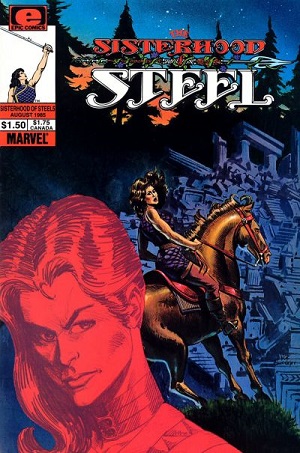 This is one of those comics where the title is of course familiar to someone of my particular generation, growing up and discovering and reading and reading about comics in the 1980s. I knew it was part of Marvel’s Epic imprint of creator-owned comics. But aside from seeing ads for it in other Epic publications and in the comics press, I couldn’t have told yhou anything about it.
This is one of those comics where the title is of course familiar to someone of my particular generation, growing up and discovering and reading and reading about comics in the 1980s. I knew it was part of Marvel’s Epic imprint of creator-owned comics. But aside from seeing ads for it in other Epic publications and in the comics press, I couldn’t have told yhou anything about it.
Well, other than it was about lady warriors, I suppose, as evident from the title. It took me doing research (i.e. looking at the Wikipedia entry) to learn that the central character of the book was a young warrior named Boronwë. The comic ran eight issues at Epic, and according to my “research,” a plan to continue the series in graphic novel format hit snags at that company, so the creators moved on to Eclipse Comics. There a single graphic novel (Baronwë: Daughter of Death) was published, and as far as I know that was that.
The creator of this comic was Christy Marx, with Mike Vosburg on art. The graphic novel was illustrated by the late Peter Ledger, who had been Marx’s first husband. So, strong talent all around, so I’m sure the comics read and looked wonderful. Unfortunately, I just never read them. And as far as I can tell, none of this material has been reprinted.
I think the original eight issue run, at least, is relatively easy to find. In fact, I spotted a few issues of it scattered throughout an enormous collection I just took in. I remember having stock of those at the previous place of employment, but I can only vaguely remember that graphic novel. Pretty sure we had it back then…I know my old boss would’ve ordered it…but I don’t think I’ve seen a copy in decades.
Seems like a shame this has been out of print for so long. Feels like something that might make a hardcover or something.
Space Ark (AC/Apple 1985-1987)
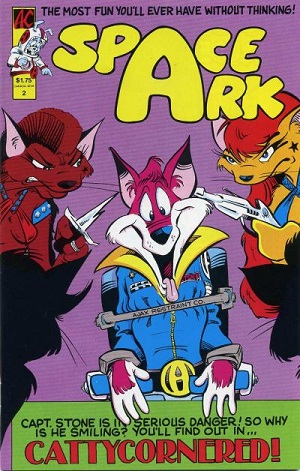 You got me, I’ve got nothin’ on this one. I knew the comic existed, but I can’t even say I sold any of these out the back issue bins while I was at the old shop. I certainly didn’t sell it new, as it wrapped up the year before I entered the business.
You got me, I’ve got nothin’ on this one. I knew the comic existed, but I can’t even say I sold any of these out the back issue bins while I was at the old shop. I certainly didn’t sell it new, as it wrapped up the year before I entered the business.
The comic is by Mark Cantrell and Ken Mitchroney…Cantrell’s name rings a bell, but a quick look on the Comics Database shows him mostly doing some things for AC Comics, a publisher I really haven’t read much from. Mitchroney’s name I do recognize for sure, most likely from his work on Marvel’s Ren and Stimpy series, though he also was the artist on Myth Conceptions, the follow-up to Myth Adventures (mostly illustrated by Phil Foglio, with Jim Valentino taking over the last couple of issues — am I padding this entry? Maybe).
The series ran five issues through two companies…the first two from AC, and the last three from Apple. (Should also note here the writer on issue #5 was author Steven R. Boyett.) A Space Ark short did appear as a back-up in Usagi Yojimbo #22, where the characters appear to cross over with that title’s lead. I don’t believe any of this material has been reprinted, save the Usagi story that apparently showed up in a German publication.
The comic was a humorous sci-fi adventure comic, featuring the anthropomorphic crew of the Space Ark, headed by Captain Stone (a fox…I mean, he was the animal the fox, not that he’s foxy, though, you know, maybe he is, again I didn’t read the comic). It seems like it’s in a similar mode as Adventures of Captain Jack, and I don’t know if I’m stepping on any toes by even mentioning that, and if so I apologize.
I mean…I know I like Mitchroney’s art, so I’m sure the book looks perfectly fine. I don’t know anything about the tone of the series, how comedic or “dramedic” or wacky or slapstick it might be. I promise, if a copy comes across my desk at my current shop, I’ll take a peek inside.
Special thanks to Wikifur for the additional research source.
The Spirit 1983 Series (Kitchen Sink 1983-1992)
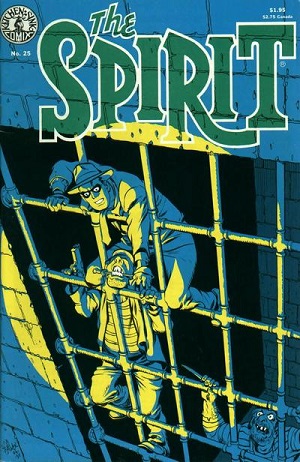
Okay, by all rights I should have disqualified this one. This isn’t really in the spirit (cough) of “Favorite ’80s Title” as I’d meant it. The series (running 87 issues over a decade) was, as far as I can tell, mostly reprints in chronological order the post-war Spirit stories by Will Eisner and others. The covers appear to be all new illustrations by Eisner, which are nice.
Now, in no way am I disparaging the material here, and I’m not saying it lacks artistic or historical value by saying it doesn’t really belong in this ’80s comics overview. But it’s not ’80s comics, it’s 1940s and 1950s comics. Yes, there are the new covers, but, well, you know what I’m getting at. I was aiming for books created in the ’80s, specifically.
But on the other hand, this series did run almost 90 issues, the 40-year-old comics competing side-by-side on the comics rack next to, I don’t know, Dazzler and Nth Man and Haywire, and outlasting many of its competitors. I’m not going to say the material is timeless (one specific element remains…controversial), but Eisner’s art and storytelling is otherwise impeccable. Many of the comics that shared the shelves with these reprints owed a great deal to Eisner’s work of the period.
In conclusion, when I eventually do this for ’90s books, don’t nominate series that are all reprints of comics from earlier decades. This one I’ll let slide because, well, it’s Eisner. And who’s gonna stop me? I’M MAD WITH POWER. And yes, I know this may complicate the Miracleman entry a bit when I get to it.
• • •
Okay, enough with that. Only a couple of entries away before we move on to the comics that got
two votes! Exciting, no? Thanks, as always, for reading, and I’ll see you on Wednesday probably.
Well, still going through the one-voters from that “fave ’80s comics” survey I ran a while back. It’s been fun going through those and finding what, if anything, I have to say about these “golden oldies.” And I apologize to anyone I just aged into dust by calling these comics from the 1980s “golden oldies.”
This time ’round there’s gonna be a series of which I haven’t read one panel, and even as I’m typing this I have no idea what I’m going to say. Let’s find out together, shall we?
The Rocketeer (Pacific/Eclipse/Comico/Dark Horse 1982-1995)
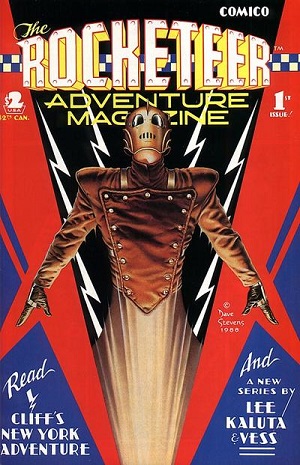 So here’s another exception to the “list just the initial series” in the header. The Rocketeer was serialized over several years, through several publications and publishers, in what was essentially one ongoing narrative, so I just lumped ’em all together here.
So here’s another exception to the “list just the initial series” in the header. The Rocketeer was serialized over several years, through several publications and publishers, in what was essentially one ongoing narrative, so I just lumped ’em all together here.
The story, written by Dave Stevens and drawn by him with the occasional assistance on layouts ‘n’ such from folks like Jaime Hernandez, began as a back-up story in Starslayer #2 and #3 from Pacific Comics. From there it continued with two more chapters in consecutive issues of the Pacific Presents anthology (1982-3), then on to a longer installment in The Rocketeer Special Edition #1 from Eclipse in 1984. Comico then released two issues of what would be technically the first Rocketeer “ongoing” series, The Rocketeer Adventure Magazine in 1988-9. And then finally, in 1995, the last part of Stevens’ story would be released as Rocketeer Adventure Magazine #3 by Dark Horse. Phew!
The early chapters, pre-Adventure Magazine, are reprinted in a full-color graphic novel from Eclipse in 1985 (which includes a couple of extra new story pages). In the 2000s, IDW would release collected editions of the whole shebang.
It is a fun story, pulpy 1930s adventure featuring a guy and his rocket-pack, and his pals, including his girlfriend Betty, very obviously patterned after real-life model Bettie Page. Stevens’ art was beautiful and meticulous and there was nothing quite like it on the stands. Sometimes the art felt a little stiff to me, without any real sense of action, but that’s a minor quibble. Despite all the delays, including a car accident, a lawsuit (Marvel suing because they said there’d be market confusion between this character some minor villains called “the Rocketeers” from the ’70s, really about as bullshit a suit as they come), a movie (perhaps you’ve heard of it), Stevens persevered and completed his story on his own terms.
Stevens would never do any more Rocketeer stories, and passed away in 2008. However, there are plenty of other Rocketeer comics out there, including the 1991 adaptation of the film published by Disney’s comics division. Probably of note due to artwork by the legendary Russ Heath, over a Peter David script. Also in 1991 was Rocketeer 3D, which was oddly another adaptation of the film drawn by Neal Adams/Continuity Studios and in, as you may have guessed, 3D.
After Stevens passed, IDW acquired the rights to do new comics, starting with the Rocketeer Adventuresanthology in 2011. Now, the IDW comics can be of…varying quality, but by and large they’re entertaining even as everyone involved is surely aware they’re trying very hard to fill some big shoes. Keep an eye out for the Rocketeer/Spirit crossover from 2013, by Mark Waid and Paul Smith. That’s a good’un.
Savage Henry (Vortex/Rip Off 1987-1993)
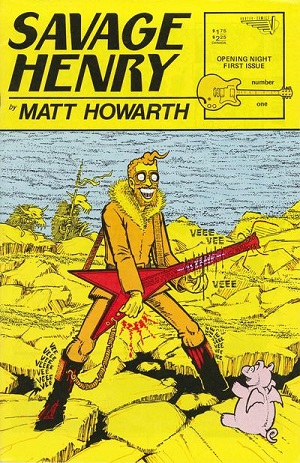 The temptation to go to ChatGPT and ask it to write this particular section for me is overwhelming. But, learning the lesson from these lawyers getting caught out doing the same thing, I will opt to tell you what I can, considering I’ve not read a single panel of any of these comics.
The temptation to go to ChatGPT and ask it to write this particular section for me is overwhelming. But, learning the lesson from these lawyers getting caught out doing the same thing, I will opt to tell you what I can, considering I’ve not read a single panel of any of these comics.
I remember selling Savage Henry on the rack, but mostly I remember the other series by Matt Howarth from about the same time, Those Annoying Post Bros.. Howarth did some other comics here and there, and at the previous place of employment we just had a “Matt Howarth” section in the back issue bins where we kept them all together. On the somewhat infrequent occasion we had someone looking for his books, that customer was generally looking for issues of all of them, and just keeping them in the same place seemed to make sense.
This comic is in fact a spin-off of Those Annoying Post Bros., a sci-fi/fantasy adventure featuring the band The Bulldaggers and its lead guitarist, the titular Savage Henry. Yes, I had to go to the Wikipedia entry amongst my research (“Siri, tell me about Savage Henry”) and apparently there was a whole pile of real-life musicians who popped up in here. I mean, I knew the Residents popped up in Howarth’s books…I definitely remember that…but, like, Steve Roach? Hawkwind? Andrew Weiss? (No, not that Andrew Weiss.)
I always thought the covers stood out, and Howarth’s art is, I think, pretty neat. I’m sorry I never got around to reading these, I’m sure they’re enjoyable.
Oh, and Savage Henry ran 13 issues from Vortex, before switching over to Rip Off Press for another 17. From that point it had a few new minis from MU Press and Caliber. No collected editions as far as I can tell, but if I’m wrong, let me know.
Scout (Eclipse 1985-1987)
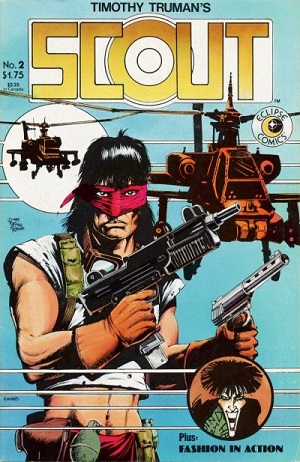 Scout was one of those titles I decided at one point, early in my career of funnybook retailin’, to collect and complete. I only ended up getting the first few issues, and can’t remember why I didn’t get more. It certainly wasn’t the quality, as the series was All Tim Truman, All the Time (except for some back-ups and a couple of guest-artist stints, by fellow Joe Kubert School alumni Rick Veitch, Steve Bissette, and Tom Yeates).
Scout was one of those titles I decided at one point, early in my career of funnybook retailin’, to collect and complete. I only ended up getting the first few issues, and can’t remember why I didn’t get more. It certainly wasn’t the quality, as the series was All Tim Truman, All the Time (except for some back-ups and a couple of guest-artist stints, by fellow Joe Kubert School alumni Rick Veitch, Steve Bissette, and Tom Yeates).
The comics feature the adventures of Native American Emanuel Santana in the near-future of a fallen America, seeking out the Great Monsters of the Apache. Inexplicably I do not own #17, which a tie-in to Tales of the Beanworld.
The initial run of Scout was 24 issues, and a couple of related mini-series not by Truman (New America and Swords of Texas. Truman would return with Scout: War Shaman, which would end after 16 issues in 1989. There’s also a Scout Handbook in there somewhere. More comics were planned, but as of yet had not been released. A hardcover for the third part of the planned saga, Scout: Warauders, was recently just funded on Kickstarter, so it looks like there’s more to come.
And I would be remiss if I didn’t brag mention my copy of the “Marauders” vinyl record by Timothy Truman and the Dixie Pistols. Becauyse, you know, it contains an 8-page Scout mini-comic. No collection is complete without it!
Reprints: Eclipse published a couple of trades back in the day, running up through issue #14 of the original series. Dynamite published a couple of reprint volumes in the early 2000s, which get up to issue #15, so…a full comprehensive printing has not yet been unleashed.
Anyway, it’s Truman, therefore it’s good. Look for those issues in the bargain boxes. There’s only a few dozen to track down, it’s not like you’ve got anything else to do.
• • •
And there’s your three for the day! Yes, I know this is taking forever but honestly it takes a lot to even do
just three comics for these entries. A new entry in the Final ’80s Countdown is coming soon…thanks for reading, pals!
Continuing the look at your picks for favorite ’80s titles:
normalman (Aardvark-Vanaheim/Renegade Press 1984-1985)
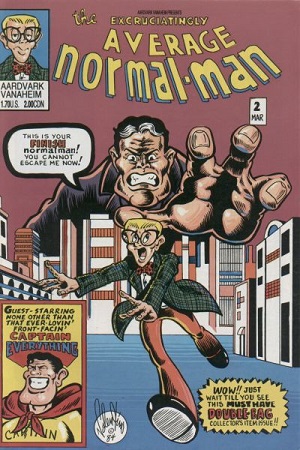 If I can let you in on a little blogging secret here…I wrote the middle bit about Pirate Corp$ first, and spent a lot of time doing so, which doesn’t leave me much time for the other two entries here. As such, I’m going to cheat a little and quote from a post I wrote nearly ten years ago on the topic of the great normalman comic:
If I can let you in on a little blogging secret here…I wrote the middle bit about Pirate Corp$ first, and spent a lot of time doing so, which doesn’t leave me much time for the other two entries here. As such, I’m going to cheat a little and quote from a post I wrote nearly ten years ago on the topic of the great normalman comic:
“I bought the first issue of normalman back in the early days of my ‘hey, I just found a comic shop and I really want to try comics by people other than Marvel and DC’ phase, mostly because, well, it looked like it would be funny.
“And it was! This probably remains my favorite work by Jim Valentino (then, only ‘Valentino’)…fun, goofy comics about the one guy without powers on a planet filled with superheroes and villains. I recognized the subjects of the parodies on each cover, even if I didn’t specifically know a whole lot about all of them at the time. A couple of friends of mine were also reading the series, and we had a good time talking about some of the gags in the book (such as the ongoing, issue-after-issue roll-call of the Legion of Super-Heroes parody, and the highly-entertaining-to-a-bunch-of-teenagers Man-Man, with his Ganja-Breath.”
I stand by all that. It’s a wonderful series, best experienced in its original individual-issue format with its great parody covers and original coloring, with the caveat that the final issue wrapping up the initial run is in 3D in case you have trouble reading such things. There have been a couple of reprint books (one from Slave Labor that reprints the first series, one from Image that seems to reprint nearly everything) that feature the story in 2-D.
There were follow-ups over the years, like Image’s normalman/Megaton Man special (that brings together lots of indie folks, especially Flaming Carrot), and the 20th Anniversary special in 2004. Hey, we’re due for a 40th anniversary special next year! Hear that, Valentino?
normalman started as a back-up in a couple of issues of Cerebus (#56-7) before popping up in his own series. He also made appearances in the Aardvark-Vanaheim AV in 3D book (1984), Marvel’s humor one-shot Epic Lite #1 (1991), a wild appearance in Journey, plus several other little bits and pieces that are reprinted in that big ol’ Image book. Not reprinted is the Max the Magnificent one-shot from Slave Labor in 1987, featuring the supporting character from normalman as well as normalman’s best pal Captain Everything.
Good stuff all around, with the initial mini being the best. Worth seeking out if you’ve not read it.
Pirate Corp$ (Eternity/Malibu 1987-1988)
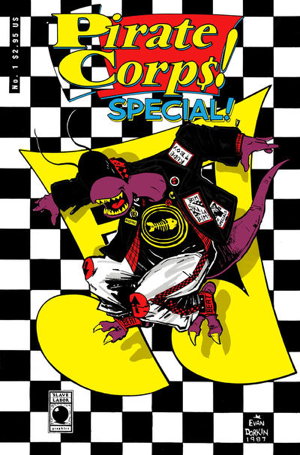 Okay, usually what I try to do here is list the first ongoing series for each property I discuss here, post a representative issue from that intial run, then in the body of the text I mention the other related series, if any. In this particular case, after the Eternity/Malibu four issue run, there was a transitional issue, the Pirate Corp$ Special released by Slave Labor in 1989 before starting their own ongoing series. That’s what I’ve got pictured here, because that was the first issue I ever bought of this title, for the primary reason that the Fishbone band t-shirt the fella’s wearin’ on the cover caught my eye. Being quite the Fishbone fan at the time, I had to pick it up and check it out, and I’m glad I did.
Okay, usually what I try to do here is list the first ongoing series for each property I discuss here, post a representative issue from that intial run, then in the body of the text I mention the other related series, if any. In this particular case, after the Eternity/Malibu four issue run, there was a transitional issue, the Pirate Corp$ Special released by Slave Labor in 1989 before starting their own ongoing series. That’s what I’ve got pictured here, because that was the first issue I ever bought of this title, for the primary reason that the Fishbone band t-shirt the fella’s wearin’ on the cover caught my eye. Being quite the Fishbone fan at the time, I had to pick it up and check it out, and I’m glad I did.
It’s a sci-fi “dramedy” following a gang of misfits and outcasts that is more sci-fi adventure when it starts out, and progressively focuses less on that and more on character-based stories during its Slave Labor run. Evan Dorkin writes and draws the book, mostly in crisp black and white, detail-filled panels (though the first two Eternity issues are in color). In addition to the four issue Eternity series and the Special one-shot, there were five issues of Pirate Corp$ from Slave Labor from ’89 to ’92, which changed its name to Hectic Planet with #6 in 1993 to reflect the de-emphasizing of the whole “this is a corp$ of space pirates” thing. Apparently there’s a second print of #5 with the new Hectic Planet logo, which I was only reminded of when researching online.
Now I was looking for something else in my collection when I came across all my Pirate Corp$/Hectic Planet comics, so I pulled them out in case I needed to reference them for this now overly-wordy blog post. And it’s a good thing I did because I 100% forgot about Hectic PLanet: The Bummer Trilogy from 2001, which I think is the final “new” bit of this series to see print. “New” is in quotes because it’s reprinting three stories from the anthology series Dark Horse Presents. Oh, and almost forgot the Vroom Socko one-shot tie-in, published in 1993, collecting material from the British comics/music mag Deadline.
The original Eternity run was republished in two black and white issues from Slave Labor under the name Pirate Corp$: The Blunder Years, and there were three trade paperbacks under the name Hectic Planet reprinting the PC/HP series with additional material.
It’s a fun series, well worth seeking out, and those three trades are likely the definitive version so look for those. (“The Bummer Trilogy” may not be included, as it was coming out around the same time as these trades. I can’t tell from the solicits on Diamond’s website and the Comics Database doesn’t have them indexed.)
One more thing, because at this point why not type more: at my previous place of employment, when these comics were being released, all of us at the shop were huge fans and recommended the comic to whomever we thought would be likely suspects. At one point our orders on the title were so high we’d get phone calls from the distributor asking if we’d meant to order that many, or if, like, a finger slipping filling out the numbers or something. “Nope, we want ’em all!” we said, and eventually we figured out we were selling about 5% of the comic’s print run. My former boss Ralph ran into Mr. Dorkin at the San Diego Con about that time and related our sales on the book to him, and according to Ralph he jumped right up and shook his hand. I certainly hope that moment made Mr. Dorkin happy, as much as his comics were, and still are, making us happy.
BONUS: this post from a couple of years ago where I show off an original Pirate Corp$ sketch in my possession, along with a much more pithy appreciation of the comic.
Puma Blues (Aardvark-One International/Mirage Studios 1986-1989)
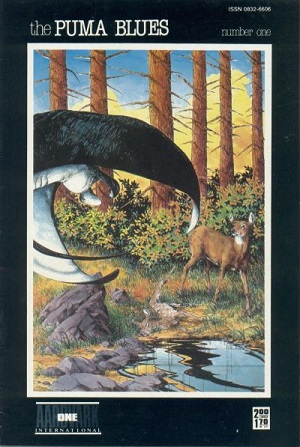 Again, see my intro for normalman above, as I’m not leaving myself much time to write about this lushly-illustrated series. You owe it to yourself to find the originals for the covers alone, as they don’t make it into this otherwise exceptional hardcover collection.
Again, see my intro for normalman above, as I’m not leaving myself much time to write about this lushly-illustrated series. You owe it to yourself to find the originals for the covers alone, as they don’t make it into this otherwise exceptional hardcover collection.
I said back in that linked post that this was a dense, challenging, and rewarding read, set in the near future of the year 2000. It takes place years after a nuclear event set off by terrorists wipes out a good chunk of America’s wilderness, and nature’s recovery and the resultant mutated animals are the object of study. Again, it’s been a while since I’ve read this, despite having that big ol’ brick of the book in my possession, but it’s one I’ve been meaning to get back to someday. It’s simply just beautiful to look at.
And as I like to remind people whenever this comes up, Puma Blues unfortunately ended up in a dispute between Dave Sim and Diamond Comics Distributors. Dave decided to sell the Cerebus book High Society trade outside of Diamond, and Diamond retaliated by not carrying Puma Blues. Wild times.
• • •
Good gravy, that’s enough for tonight. Back to it next week! Thanks for reading, pals.
Doc Stearn…Mr. Monster (Eclipse 1985-1987)
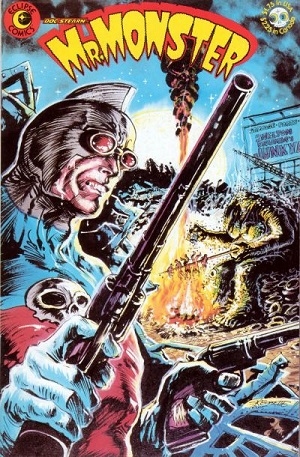 …Whoops, entered it on my master list of ’80s vote-getters under “Mr. Monster” instead of the full real name, as shown above, which is why I didn’t get to it ’til the Ms. Sorry, person who voted for this comic and was probably wondering why I skipped it!
…Whoops, entered it on my master list of ’80s vote-getters under “Mr. Monster” instead of the full real name, as shown above, which is why I didn’t get to it ’til the Ms. Sorry, person who voted for this comic and was probably wondering why I skipped it!
Anyway, Michael T. Gilbert based this wacky monster-non-approving hero on a relatively straight-laced and public domain Golden Age comics character by the same name, and he and William Messner-Loebs and, of course, the amazing lettering of Ken Bruzenak, Other creators would hop on board, such as Alan Moore scripting an adventure in #3 (pictured), but it was mostly Gilbert who was the master of ceremonies here.
There were a number of spin-offs, including Mr. Monster’s Super Duper Specials reprinting Golden Age material with new wraparound comics by Gilbert. All good, but the two “Hi-Shock Schlock!” issues are indispensable.
I’m not going to try to list every Mr. Monster spin-off here, as there were plenty, running well into the 2010s, from its original home at Eclipse, to Image Comics, to Tundra, to Dark Horse and more. There was even a Penthouse Comix publication that had a Mr. Monster story…which, despite being called “Penthouse Max,” I think it was…if not general audiences, at least non-porn. Wasn’t like I was going to sell anything called “Penthouse” to kids, regardless.
While most of the spin-offs post that initial Eclipse series were more in the wild comedic over-the-top mode, the most notable follow-up may have been the eight part mini-series from Dark Horse. It was in black and white, a sharp contrast to Doc’s usual colorful adventures, and it was a more-or-less serious retelling of the character’s origins. Quite good, beautifully done, but at the time I felt like the character’s humorous momentum was curtailed by this somber aside and it never really got back on course.
I mean, clearly there was still plenty of funny Mr. Monster to be had, and I bought and enjoyed pretty much all of it, but I never really got that same…entertaining, “anything goes” anarchic feeling that I had in that original 10-issue run. Don’t get me wrong, that origin mini is great, but if you read the funny Mr. Monster first and decide you like it, maybe read the rest of the output before tacking that backstory.
Ms. Tree (Eclipse/Aardvark-Vanaheim/Renegade Press 1983-1989)
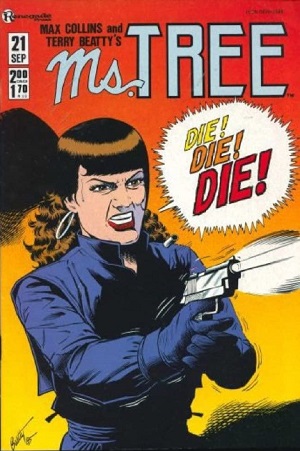 Okay, how many times have I told this story? I was buying the Ms. Tree comics, an ongoing saga about a lady detective and the tangled web her violent tactics can weave, for quite some time before getting my job working at a comic book store. Early at that job, someone asked for the Ms. Tree back issues. I replied, “sure, let me get the Ms. Trees for you…wait, hold on. ‘Ms. Tree.’ ‘Mystery!’ I get it!”
Okay, how many times have I told this story? I was buying the Ms. Tree comics, an ongoing saga about a lady detective and the tangled web her violent tactics can weave, for quite some time before getting my job working at a comic book store. Early at that job, someone asked for the Ms. Tree back issues. I replied, “sure, let me get the Ms. Trees for you…wait, hold on. ‘Ms. Tree.’ ‘Mystery!’ I get it!”
Because, you know, I never had occasion to say the name aloud before. I only ever just saw it as a name. “Ms. Michael Tree.” Also, I was a dumb teenager. Even by “dumb teenager” standards.
But anyway, Ms. Tree started out in Eclipse Magazine #1 in 1981, with the first chapter of a serialized story by Max Allan Collins and Terry Beatty. It ran there for a few issues before graduating into its own 50-issue-long ongoing series…Ms. Tree’s Thrilling Detective Stories for hte first three issues, before shorting to Ms. Tree for the rest of its run through three publishers (noted above). Early issues of the run (including the Eclipse Magazine stories) were reprinted in the ’80s in a three-issue book series called Files of Ms. Tree, but currently the UK publisher Titan is releasing new reprint volumes (the newest one, Heroine Withdrawal, coming this October).
During that initial run, there were a couple of fun spin-offs, including a 3-D issue that features the cleverly named new story “Death, Danger and Diamonds” (because…3 Ds, you see) and a reprint of a story from AV in 3D (the Aardvark-Vanaheim 3D special). The new story here is reprinted in Files of Ms. Tree volume 3 in 2-D black and white, if you’d rather read it that way. In addition, there’s a crossover mini-series with E-Man‘s Michael Mauser called The P.I.s which is worth a look.
After that main run wraps up, the saga continues over at DC Comics as Ms. Tree Quarterly and Ms. Tree Special. Those end in the early-mid 1990s and I think that’s more or less been it since then for new Tree stories. At least in comics, as the character did appear in a prose novel by Collins, Deadly Beloved, released in 2007. Which I’m pretty sure I have around here but haven’t got around to reading yet. (There are a handful of other prose short stories with Ms. Tree, two in the Files collections, and then a couple that appeared in mystery anthologies in the early ’90s.
Speaking of reading…like I said above, I did read all of the comics. It’s a fun, occasionally violent, occasionally brutal, occasionally…Shakespearean? (Romeo and Juliet specifically, when Tree’s son and the daughter of a mob boss fall in love). Plenty of melodrama to be had, and Tree’s tactics have serious consequences for her (turns out you if you solve all your problems with violence, folks are gonna look a bit askance at you). Also, the cover pictured here is maybe the best cover of the series…really lets you know what you’re in for.
Of special note is #50 from Renegade, which includes a flexidisc with “The Theme from Ms. Tree” as performed by Cruisin’ (Collins on keyboards, if memory serves). There’s a CD (long out of print, I’m assuming) that has the track on there, too.
Neat Stuff (Fantagraphics 1985-1989)
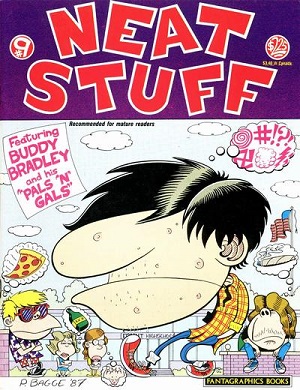 For whatever reason, though I was on the lookout for new alternative material around the mid-1980s, and I was buying Fantagraphics label-mates like Love and Rockets and Lloyd Llewellyn, among others, I didn’t really catch onto Peter Bagge’s Neat Stuff until, well, way into its run. Like, “the last couple of issues” late.
For whatever reason, though I was on the lookout for new alternative material around the mid-1980s, and I was buying Fantagraphics label-mates like Love and Rockets and Lloyd Llewellyn, among others, I didn’t really catch onto Peter Bagge’s Neat Stuff until, well, way into its run. Like, “the last couple of issues” late.
I’ve no excuse. I mean, I saw them on the shelves. I knew it existed. I just never got around to picking it up, and now that I’m in my strange “let’s fill holes in my comic collection” phase of acquiring original publications of material I mostly have otherwise, maybe this is a run I can eventually acquire.
I must have liked those two issues of Neat Stuff enough to pick up his new comic-book-sized series, Hate, when it started in 1990. The new series focused on the l life of Buddy Bradley, the approaching-adulthood slacker son of the Bradley family that had been a prominent component of the preceding Neat Stuff. At any rate, I was totally in the Bagge (hold for applause) for these comics, so when Fantagraphics collected the older Bradleys material, as well as other work from those magazines, into four trade paperbacks, I bought them all.
I’m not 100% certain how to best describe Neat Stuff. Wild, occasionally vulgar, humor with unpleasant characters in upsetting situations that will shame you into laughing, and it’s terrific. There is a slipcased hardcover set The Complete Neat Stuff currently available if you don’t want to be a weirdo like me who wants to get the all the originals to see this material in its initial context.
• • •
That’s enough of that…will be on to part nine of this overview of the one-voters from
this survey soon. Thanks for reading as always, pals, and I’ll see you back here soon.
« Older Entries
Newer Entries »
 Concrete (Dark Horse 1987-1988)Paul Chadwick’s large rocky fella has been missing from the stands for quite a while (though with the occasional promise of a new series coming down the pike), but the character retains a beloved following among the comics cognoscenti even today.
Concrete (Dark Horse 1987-1988)Paul Chadwick’s large rocky fella has been missing from the stands for quite a while (though with the occasional promise of a new series coming down the pike), but the character retains a beloved following among the comics cognoscenti even today. Yummy Fur started as a
Yummy Fur started as a 
 Hoo boy, where do I even start. Stan Sakai’s samurai rabbit has been going strong since debuting in Albedo Anthropomorphics #2 in 1984. After some appearances in that anthology, Usagi moved over to Fantagraphics, first in the anthology Critters, then a one-shot special, and then a 38-issue run of his own series (the one noted in the header above). From there the character moved to Mirage (the original publisher of Teenage Mutant Ninja Turtles) for a short run, then it was off to Dark Horse Comics for its longest numbered run from ’96 to 2018. Since then new Usagi has been coming from IDW, in both an ongoing series and various minis.
Hoo boy, where do I even start. Stan Sakai’s samurai rabbit has been going strong since debuting in Albedo Anthropomorphics #2 in 1984. After some appearances in that anthology, Usagi moved over to Fantagraphics, first in the anthology Critters, then a one-shot special, and then a 38-issue run of his own series (the one noted in the header above). From there the character moved to Mirage (the original publisher of Teenage Mutant Ninja Turtles) for a short run, then it was off to Dark Horse Comics for its longest numbered run from ’96 to 2018. Since then new Usagi has been coming from IDW, in both an ongoing series and various minis.  But Xenozoic Tales ain’t no slouch either. Mark Shultz’s very EC Comics-inspired series is set in a post-apocalyptic future where prehistoric beasts once again roam the Earth. The concept was introduced in a short story in the Kitchen Sink legacy underground title Death Rattle in ’86, before getting its own series in ’87. 14 issues were produced in a ten year span afterwards, taking a while due to the meticulous art, but probably also due…
But Xenozoic Tales ain’t no slouch either. Mark Shultz’s very EC Comics-inspired series is set in a post-apocalyptic future where prehistoric beasts once again roam the Earth. The concept was introduced in a short story in the Kitchen Sink legacy underground title Death Rattle in ’86, before getting its own series in ’87. 14 issues were produced in a ten year span afterwards, taking a while due to the meticulous art, but probably also due… I recently had…not a full set of all the Elementals (at least, the “good” ones, more on that in a moment), but pretty close, and a friend who had an interest in reading those but missed ’em the first time around expressed interest. After taking them home and reading them, he reported back “…um, yeah, not for me.”
I recently had…not a full set of all the Elementals (at least, the “good” ones, more on that in a moment), but pretty close, and a friend who had an interest in reading those but missed ’em the first time around expressed interest. After taking them home and reading them, he reported back “…um, yeah, not for me.”  I wrote about Nexus a
I wrote about Nexus a  Hoo boy, okay, here’s the one when I first saw it mentioned I realized “I’ve got a lot of vamping up ahead given the number of comics in this list I haven’t read or even have stories about.” And I apologize…I do recall this comic, about a volunteer in the Peace Corps and her work in Africa, coming out and having a small but loyal following at the shop. Written by Cindy Goff and Rafael Nieves, and illustrated by Seitu Hayden, the series spanned three publishers: the eleven black and white issues from the companies noted above, and two one-shot color specials published under Marvel’s Epic imprint in the early 1990s.
Hoo boy, okay, here’s the one when I first saw it mentioned I realized “I’ve got a lot of vamping up ahead given the number of comics in this list I haven’t read or even have stories about.” And I apologize…I do recall this comic, about a volunteer in the Peace Corps and her work in Africa, coming out and having a small but loyal following at the shop. Written by Cindy Goff and Rafael Nieves, and illustrated by Seitu Hayden, the series spanned three publishers: the eleven black and white issues from the companies noted above, and two one-shot color specials published under Marvel’s Epic imprint in the early 1990s. Where do I even start. Well, first, only one vote? Very surprising, even given the rather limited reach of my “poll.” Anyway, pictured there is issue #2 of the original series, the first to make it out to my local shop at the time (to be followed by a reprint of #1 a few weeks later). The first four issues were magazine-sized (apparently due to a misunderstanding between creators Kevin Eastman and Peter Laird and their printer), before finally going to a more standard comic size.
Where do I even start. Well, first, only one vote? Very surprising, even given the rather limited reach of my “poll.” Anyway, pictured there is issue #2 of the original series, the first to make it out to my local shop at the time (to be followed by a reprint of #1 a few weeks later). The first four issues were magazine-sized (apparently due to a misunderstanding between creators Kevin Eastman and Peter Laird and their printer), before finally going to a more standard comic size.  I didn’t read Timespirits, but I should have, given I’m a fan of artist Tom Yeates, who, with Steve Perry, produced all eight issues of this series.
I didn’t read Timespirits, but I should have, given I’m a fan of artist Tom Yeates, who, with Steve Perry, produced all eight issues of this series.  I could’ve sworn this series ran longer than it did, but on the other hand, the three or four year duration of the series was a lot longer than its twelve-issue run would suggest.
I could’ve sworn this series ran longer than it did, but on the other hand, the three or four year duration of the series was a lot longer than its twelve-issue run would suggest.  A reminder to folks new to these lists, that I was counting creator-owned books released under Marvel’s “Epic” imprint as part of the “indies” movement since they were mostly distinct from Marvel’s standard output. I mean, despite the fact Marvel’s editorial hand
A reminder to folks new to these lists, that I was counting creator-owned books released under Marvel’s “Epic” imprint as part of the “indies” movement since they were mostly distinct from Marvel’s standard output. I mean, despite the fact Marvel’s editorial hand  Another one of those darned Epic titles, this one with the subtitle on the cover “…And The All-Purpose Power Tool.” Which I don’t know was officially part of the title or not, since I don’t have a copy here to check the indicia.
Another one of those darned Epic titles, this one with the subtitle on the cover “…And The All-Purpose Power Tool.” Which I don’t know was officially part of the title or not, since I don’t have a copy here to check the indicia.  I’ll tell you what, though, when I saw that cover of Strange Days as a 15-year-old kid wandering around ye olde comic shoppe, that was a book I had to have. That weird face in the background, those obnoxious colors…it was a comic that dared you to buy it, and friends, I took that dare.
I’ll tell you what, though, when I saw that cover of Strange Days as a 15-year-old kid wandering around ye olde comic shoppe, that was a book I had to have. That weird face in the background, those obnoxious colors…it was a comic that dared you to buy it, and friends, I took that dare.  This is one of those comics where the title is of course familiar to someone of my particular generation, growing up and discovering and reading and reading about comics in the 1980s. I knew it was part of Marvel’s Epic imprint of creator-owned comics. But aside from seeing ads for it in other Epic publications and in the comics press, I couldn’t have told yhou anything about it.
This is one of those comics where the title is of course familiar to someone of my particular generation, growing up and discovering and reading and reading about comics in the 1980s. I knew it was part of Marvel’s Epic imprint of creator-owned comics. But aside from seeing ads for it in other Epic publications and in the comics press, I couldn’t have told yhou anything about it.  You got me, I’ve got nothin’ on this one. I knew the comic existed, but I can’t even say I sold any of these out the back issue bins while I was at the old shop. I certainly didn’t sell it new, as it wrapped up the year before I entered the business.
You got me, I’ve got nothin’ on this one. I knew the comic existed, but I can’t even say I sold any of these out the back issue bins while I was at the old shop. I certainly didn’t sell it new, as it wrapped up the year before I entered the business. 
 So here’s another exception to the “list just the initial series” in the header. The Rocketeer was serialized over several years, through several publications and publishers, in what was essentially one ongoing narrative, so I just lumped ’em all together here.
So here’s another exception to the “list just the initial series” in the header. The Rocketeer was serialized over several years, through several publications and publishers, in what was essentially one ongoing narrative, so I just lumped ’em all together here.  The temptation to go to ChatGPT and ask it to write this particular section for me is overwhelming. But, learning the lesson from
The temptation to go to ChatGPT and ask it to write this particular section for me is overwhelming. But, learning the lesson from  Scout was one of those titles I decided at one point, early in my career of funnybook retailin’, to collect and complete. I only ended up getting the first few issues, and can’t remember why I didn’t get more. It certainly wasn’t the quality, as the series was All Tim Truman, All the Time (except for some back-ups and a couple of guest-artist stints, by fellow Joe Kubert School alumni Rick Veitch, Steve Bissette, and Tom Yeates).
Scout was one of those titles I decided at one point, early in my career of funnybook retailin’, to collect and complete. I only ended up getting the first few issues, and can’t remember why I didn’t get more. It certainly wasn’t the quality, as the series was All Tim Truman, All the Time (except for some back-ups and a couple of guest-artist stints, by fellow Joe Kubert School alumni Rick Veitch, Steve Bissette, and Tom Yeates).  If I can let you in on a little blogging secret here…I wrote the middle bit about Pirate Corp$ first, and spent a lot of time doing so, which doesn’t leave me much time for the other two entries here. As such, I’m going to cheat a little and quote from
If I can let you in on a little blogging secret here…I wrote the middle bit about Pirate Corp$ first, and spent a lot of time doing so, which doesn’t leave me much time for the other two entries here. As such, I’m going to cheat a little and quote from  Okay, usually what I try to do here is list the first ongoing series for each property I discuss here, post a representative issue from that intial run, then in the body of the text I mention the other related series, if any. In this particular case, after the Eternity/Malibu four issue run, there was a transitional issue, the Pirate Corp$ Special released by Slave Labor in 1989 before starting their own ongoing series. That’s what I’ve got pictured here, because that was the first issue I ever bought of this title, for the primary reason that the Fishbone band t-shirt the fella’s wearin’ on the cover caught my eye. Being quite the Fishbone fan at the time, I had to pick it up and check it out, and I’m glad I did.
Okay, usually what I try to do here is list the first ongoing series for each property I discuss here, post a representative issue from that intial run, then in the body of the text I mention the other related series, if any. In this particular case, after the Eternity/Malibu four issue run, there was a transitional issue, the Pirate Corp$ Special released by Slave Labor in 1989 before starting their own ongoing series. That’s what I’ve got pictured here, because that was the first issue I ever bought of this title, for the primary reason that the Fishbone band t-shirt the fella’s wearin’ on the cover caught my eye. Being quite the Fishbone fan at the time, I had to pick it up and check it out, and I’m glad I did.  Again, see my intro for normalman above, as I’m not leaving myself much time to write about this lushly-illustrated series. You owe it to yourself to find the originals for the covers alone, as they don’t make it into
Again, see my intro for normalman above, as I’m not leaving myself much time to write about this lushly-illustrated series. You owe it to yourself to find the originals for the covers alone, as they don’t make it into  …Whoops, entered it on my master list of ’80s vote-getters under “Mr. Monster” instead of the full real name, as shown above, which is why I didn’t get to it ’til the Ms. Sorry, person who voted for this comic and was probably wondering why I skipped it!
…Whoops, entered it on my master list of ’80s vote-getters under “Mr. Monster” instead of the full real name, as shown above, which is why I didn’t get to it ’til the Ms. Sorry, person who voted for this comic and was probably wondering why I skipped it! Okay, how many times have I told this story? I was buying the Ms. Tree comics, an ongoing saga about a lady detective and the tangled web her violent tactics can weave, for quite some time before getting my job working at a comic book store. Early at that job, someone asked for the Ms. Tree back issues. I replied, “sure, let me get the Ms. Trees for you…wait, hold on. ‘Ms. Tree.’ ‘Mystery!’ I get it!”
Okay, how many times have I told this story? I was buying the Ms. Tree comics, an ongoing saga about a lady detective and the tangled web her violent tactics can weave, for quite some time before getting my job working at a comic book store. Early at that job, someone asked for the Ms. Tree back issues. I replied, “sure, let me get the Ms. Trees for you…wait, hold on. ‘Ms. Tree.’ ‘Mystery!’ I get it!”  For whatever reason, though I was on the lookout for new alternative material around the mid-1980s, and I was buying Fantagraphics label-mates like Love and Rockets and Lloyd Llewellyn, among others, I didn’t really catch onto Peter Bagge’s Neat Stuff until, well, way into its run. Like, “the last couple of issues” late.
For whatever reason, though I was on the lookout for new alternative material around the mid-1980s, and I was buying Fantagraphics label-mates like Love and Rockets and Lloyd Llewellyn, among others, I didn’t really catch onto Peter Bagge’s Neat Stuff until, well, way into its run. Like, “the last couple of issues” late. 






